
DFW
-
Posts
90 -
Joined
-
Last visited
Content Type
Profiles
News and Information
Tutorials
Product Reviews
Supplier Listings
Articles
Guitar Of The Month
Links and Resources
Forums
Gallery
Downloads
Posts posted by DFW
-
-
I'm very interested in the sitar style sympathetics that Carlson has employed though, although I haven't found much information other than what Fred has provided. Are there any recordings of the sympitars?
Alex DeGrassi is a close friend of Fred's and just finished recording a few tracks on the New Dream guitar. He also has some stuff on Fred's older sympitars. Here's some info on those: http://www.beyondthetrees.com/disc.htm
-
Not sure if you figured this out yet, but I'd recommend checking out Fred Carlson's stuff (www.beyondthetrees.com). His Harp-Sympitars sound amazing, with 12 sympathetic strings running inside the neck and under the top. They tune at the main headstock and anchor at the bridge, with a little jiwari (sitar-esque buzzing bridge) mounted on the inside of the soundboard. The only place you see the sympathetic strings is through the soundhole, and you need a trapdoor in the back of the guitar to access them. The guitars sound crazy, like a band of angels buzzing inside. Hope this helps.
-
Well, I was leaning toward the tailpiece style bridge setup, and was thinking that if the bass strings had an easier time of moving the soundboard, and with longer fannish braces moved more of it. With a pin bridge I can see this not being much of an issue, but with sound being made by pushing at different pressures and frequencies I could see the asymmetrical board being advantageous.
-
I'm just going to throw in something I've been tossing around. I was looking at a few things, specifically Ribbeke's Halfling, The Kasha/Schneider, Lattice style, and Fred Carlson's DreadNautilus and kinda got thinking this: How about an asymmetrically domed top (12' on treble and 25' on bass perhaps) braced with fanned lattice (tighter on the treble side and wider on the bass)? I'd use Carlson's leaf-bracing technique to handle the whole odd dish situation. Does that make sense? Is it straight kooky? Alls I know is I want to try it.
-
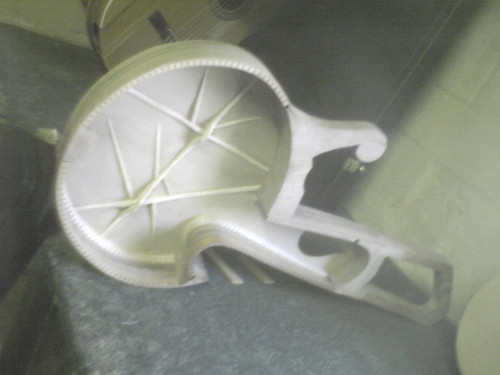
I have very little idea what I'm doing, this instrument is basically wallking through a cave, my night vision just starting to work, and a lot of guessing as to where I should go. I know it'll be a bolt on neck and there'll be a trap door out back to get at the bolts. This one goes to my girlfriend, it's an experiment we're doing trying to figure out how to build her dream instrument.
The harp bass is in the back seat for some time. So I threadjacked meself.
-
Oh yea, I finished the bass and the acoustic is due this friday so it should be done by then.
-
Now it looks like this:
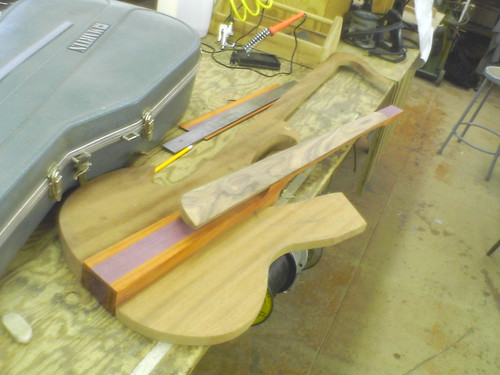
Also got the Mandolele approved, trying to get together materials and such for that.
-
Shot laquer and pore filled bass.
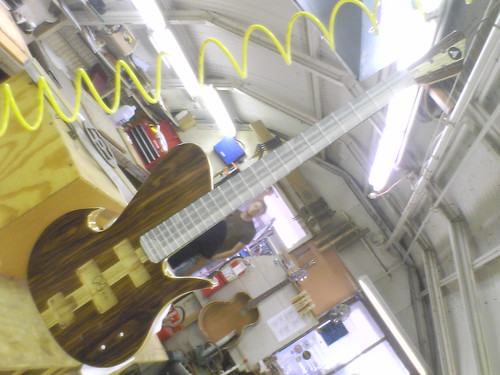
The soundbox fell from four feet and the trble upper bout binding got compressed, the top cracked and popped off the body. To repair I cut the top seperate from the binding with a razor and dumped a bunch of superglue in there, clamped close for 15 minutes, then spread the crack and stuck some titebond down in there, then clamped it closed for 45 minutes. It's all good, only sign of damage is the flat part of the binding, which isn't too noticable.
-
Either way, you're not going to convince me, and I probably won't convince you, so I think I'm done arguing
 . I do like your design and it looks like it's turning out really well - I look forward to seeing the results of this one and your other RV projects.
. I do like your design and it looks like it's turning out really well - I look forward to seeing the results of this one and your other RV projects.Heh, well I'm just doing what I've been taight and experienced. Maybe all of the teachers build instruments that do somethin special.
-
Actually, we are talking about the frequency. A given note corresponds to a specific frequency. The low E on a bass is 41.2 Hz. For the low E string to have the pitch E, it must vibrate at 41.2Hz. For a given type/thickness of string, with a given distance between the nut and saddle, that requires a specific tension.
Which is tighter if the overall length is longer. The string doesn't stop at the nut, it stops at the tuning machine. The endpoint for tension is the anchor, not the pivots. The ferrule, not the saddle, the tuning machine, not the nut.
-
It's arguable that it makes a difference for bending. Physics does back that up, but even then, you have it backwards - it's easier to bend a string which has more length past the nut, not harder.
I disagree. Think about it for a second.
The frequency of an oscillating, elastic string (i.e. a guitar or bass string) depends on the length of the oscillating string (the length that actually oscillates, i.e. saddle to nut), the mass of the string, the elastic coefficient of the string, and the tension of the string. For a given string type and scale length, there is ONE tension which achieves a certain frequency oscillation - it doesn't matter how much string there is past the nut.I disagree. We aren't talking about the frequency. Take a 6 inch string with 50 pounds of tension on it and with a pivot 1 inch from the edge and it will feel like a 6 inch string, but the pitch will be higher, and the circle of rotation tighter. It's like having a 38 inch scale length with a capo at the third fret or so. The tension will be higher.
-
How will it up the tension? The distance between the bridge and nut is still the same.
The entire string length is what matters. Hence the reverse headstock, why Hendrix could bend his ass off on the upside down strats, etc.
-
Wouldn't that make the tuning on the B string backwards compared to the others?
Yes, but it would also up the tension on Fatty Slappy B String quite a bit, and with mine being a C that extra tension is mega improtant
-
A quick question on your headstock: have you made sure that all the runs from tuner to nut are clear? It looks like some of the tuner holes may end up in the way of the strings going from other tuners to the nut.
It is starting to look really good, though.
The B string goes to the tuner furthest from the nut, as in the Fodera Extended B setup:

I also got in trouble for cutting out that horn, apperently it;s going to be tough to finish. I don't mind doing extra work, and if anyone hsa any advice on spraying or sanding it that would be much appreciated. Thanks.
-
Finally!
 I'm looking forward to see this finished!
I'm looking forward to see this finished! 
Alright, My brain took over and things are changing, it has it's own agenda and my concious aint' privy to the aims. Here's the picture of what I've got so far:
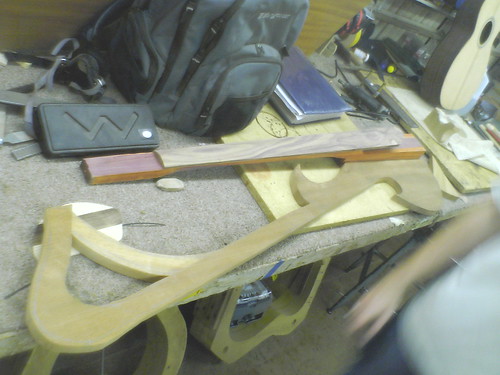
It's morphed into a harp bass with the long strings rather than short. We'll see where this goes.
By the way, this is no longer my official 3rd instrument, as it is unsanctioned and unauthorized. I am going to have a set plan, proposal and all the specifics set before construction. My third instrument is going to be this, a Fanned Fret Harp Mandolele. I've been working on the design for the past 3 weeks in conjunction with William Eaton, and now I'm toying with bracing paterns. I've also decided to bend sides rather than do what's pictured, rout them from a body blank. t's going to have 8 nylon main strings tuned organically in a combination of mando and uke tunings with six harp strings tuned organically to something as yet undetermined, though they will be in the register of a guitar's upper mids. The top is to be Cedar and the back, sides and fingerboard will be Pau Ferro. The neck will be mahogany. Same as our acoustics, the back will be radiused to 15' and the top to 30' and glued on at 50'. William and I were discussing the plan today and the innards are going to be changing quite a bit, but the profile you see is the profile it will be. The scales are 15 1/2" and 13 7/8".
-
it's not straight on, but it's pretty close.

-
O' ficially in progress:
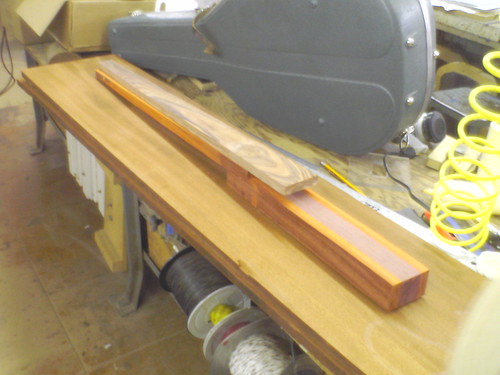
-
-
As a worshiper of Antonio Stradivari I would like to suggest you don't try and associate with him just because your guitar has cutouts on the side. Thanks.
-
Sanded sides flat on the acoustic, and I'm using koa/.040 maple binding. I also incorporated my signature "bloop" on the electric, as I felt it was more than necessary.
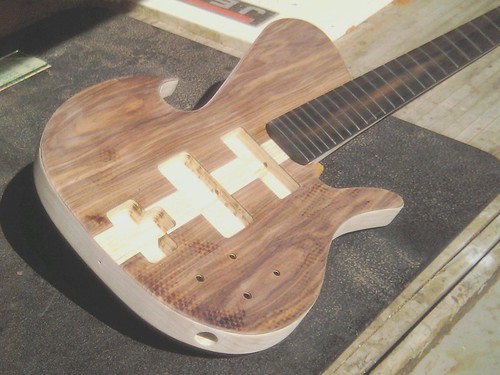
-
After reviewing the evolution of the design, I think I like the second version better. However, in my opinion, I think it would look better without those wings. I gives it a bit of a neo classical look and reminds me of a harp. Anyone?
Well, I can't get rid of them because they're my trademark, and I love them. Also they make playing it a lot more comfortable.
-
I think that one of the better ways to get the symps to move is to have them anchored to the bridge somehow to take advantage of its rotational movement. I have also thought about an extension off the bottom of the bridge that only needs to be maybe 1/2' to 3/4" long, just enough to amplify this movement.
~David
Well in my original idea the symps ran over the same bridge as the main bass strings, as it's a custom near-cello sized bridge and has the height necessary to have two planes opf strings.
-
ah yeah that happened to people too, it sucks, i double sided taped those delrin blocks to my headstock to keep that from happening
Good thinkin, I'll kep that in mind for the future.
Oh yea, by the way I've glued up my sound box and in the process of sanding the sides smooth. I also fretted the bass and that'll all be dressed tomorrow or over the weekend.
-
Well, since I don't plan on being a professional luthier or selling this idea to the masses for that matter, let me get you thinking about a design.
Your second course of strings is slightly shorter than the bass strings and have a bridge located somewhere between the main bridge and the end of the neck. The symp. strings anchor at the headstock, but are tuned at the body end using something like steinberg gearless tuners, with the strings going over a tom before hitting the tuners, of course. the signal from the main course is picked up by a mag. pickup and to sent some form of a sustainer meant to recieve a bass signal but drive guitar size strings(the symp. course). Since your symp. strings' pickup would also fall under the main course, a mag pickup is out of the question here. Instead, perhaps piezos in the tom bridge. Have the ability to tweak your symp tone and main tone, and probably the relative volumes of the two before sending them to your amp and you're in business. The whole concept makes me think of reverb that plays complimentary notes rather than the same notes the guitar plays.
What's the neck made from, you ask? Well, it's a completely hollow kevlar/carbon fiber neck of course!

just remember where you hear it first.

peace,
russ
That's a pretty darn good idea, and it seems everything is figured out, But I'm currently in no position tobuild something like that, especially that neck. All I have to work with is wood basically. And it's kinda all I want to work with, but that's just personal philosophy. I'll probably just end up building this completely acoustically in the enar future instead of here.

I Can Help You With Your Kahler Questions.
in Solidbody Guitar and Bass Chat
Posted
Hey, I had the five string bass a while back, and I've had some issues.
Mostly the string spacing is way to close for me to play comfortably, probably since it shares the 4 string chassis, just with an added saddle. Also the hook for the B string is too narrow for a .125 string, just wondering if widening it weakens the part. Maybe 5 string trems should come on either a 4 or 6 string chassis depending on the application.